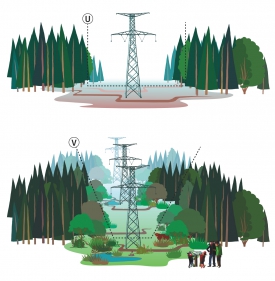News
2016-10-19
Restoration of forest edges in ForÍt d'Orient (F)
The LIFE Elia-RTE site in Forêt d'Orient (Troyes, Aube, France) comprises two major actions: management by sheep grazing and restoration of forest edge as alternative methods of vegetation management.
In this early autumn 2016, the time had come to restore the forest edges!
The site of Forêt d'Orient
We have already mentioned this site several times in our news (1, 2, 3, 4).
On limestone soil, this site shelters a grazing area of 1.4 ha made by a herd of 60 to 120 sheep belonging to a motivated local breeder.
The other part of the site concerns 2 ha of very dynamic vegetation. In collaboration with our local partners (RTE, Natural Park of the Forest of Orient, Conservatory of natural areas Champagne-Ardenne, Town Hall of Brienne-la-Vieille and a local breeder), we decided to manage them by restoring forest edges.
Restoration of structured forest edges: the principle
The vegetation management in stepped edges makes it possible to avoid the repeated cuts carried out either manually or by a rotary slasher. The main idea is to move from a U-shaped electrical corridor to a truncated V-shaped corridor. We have devoted a booklet explaining in detail all that concerns this action.

In the case of the Forêt d'Orient, restoration is possible because there are many indigenous bushy indigenous species present on site that are interesting for biodiversity (flowering, fruiting, shelter...). Their final height will pose no problem for the conductors (overhead cables) transmitting electricity.
We found the following species on site : European spindle (Eonymus europaeus), Hawthorns (Crataeugus monogyna and Crataegus laevigata), Privet (Ligustrum vulgare), Hazelnut (Corylus avellana), Willow (Salix sp) or the Common Dogwood (Cornus sanguinea).
But also a series of woody species against which it is necessary to actively fight because of their height in adulthood: Common alder (Alnus glutinosa), Sycamore (Acer pseudoplatanus), Norway maple (Acer campestre), Black locust (Robinia pseudoacacia), Grey poplar (Populus × canescens), Common aspen (Populus tremula), Pedunculate oak (Quercus robur) or Ash (Fraxinus excelsior).
By cutting off these problematic species, bushy species will be able to settle freely and will thus be able to further reduce the light input necessary for the germination and growth of the largest species.
The restoration of forest edges: the different steps
- When the vegetation is 2 to 4 meters high, recognition of the problematic species is done with personnel trained in botanical identification. The whole parcel to be secured is travelled at the beginning of the works. This makes it possible to assess the scope of the work. A colour bomb marker can be made to facilitate future work by spotting species that must be removed.
- In order to facilitate the work but to assess the necessity according to the vegetation, a penetration corridor is made with the brush cutter midway between the central part of the corridor and the edge of the forest stand. The teams then run along both sides of the corridor, parallel to the line, cutting the feet of the species to be eliminated with the chainsaw.
- The cut seedlings are put horizontally (on the ground if possible), ideally aligned in parallel with the conductors, to show that they have been cut. It will make it more easy during the check at the end of the work and to facilitate the displacement thereafter.
Work on site with RTE teams and local partners
On the occasion of this restoration, the LIFE Elia-RTE team invited the teams of RTE and the local partners.
After a theoretical part indoor, practical training in the field made it possible to show on site the technical aspects.

The interactive training was composed by two main modules: recognition of plant species and cutting methods. At each stage, exchanges on the practice of RTE and the experience of the LIFE team took place on various subjects: accessibility, validation of the work carried out, submission of contracts, skills of the work teams, identification of the species... A video was shot during this practical day.




The left side of the corridor was restored, the problematic trees were cut.

The left side of the corridor (on the right in the photo) has been restored, the problematic trees have been cut.

These two days of exchange made it possible to highlight one of the solutions to : taking into account of the biodiversity, respect the landscapes, and especially guarantying electrical safety. The goal is not to restore edges everywhere under the high voltage lines, but to be able to implement this action where it is possible.









